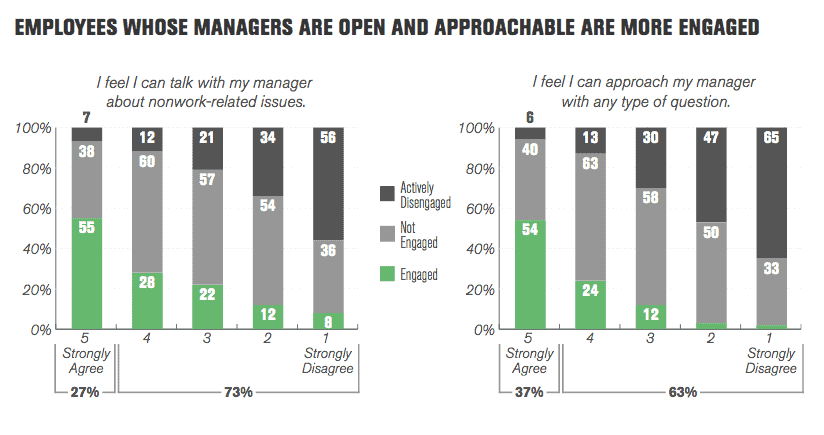Managers are always coming up with creative approaches to try to help their teams. Unfortunately, some of those ideas do more harm than good. Group 1 on 1s are one such example.

Group != 1 on 1
For many of you, you'll be puzzled by this suggestion that 1 on 1s would be anything but between a team member and their direct manager. This is absolutely true, and we'll dive into why that dynamic is so important.
It sounds good on paper...
The reasoning behind group 1 on 1s comes from a good place of trying to help.
If you thought this way, we know you have the best intentions, and think a group approach can help. You're probably trying them for an innocent reason like one of the following:
- You and your co-founder want to stay connected with everyone on your team as you grow. It seems logical to then have both of you meet with everyone.
- You and fellow veteran, informal leaders in a flat organization want to support your colleagues more. You figure if you all meet with each person, it will seem less hierarchical.
- You are training a new manager and want to sit in on some of their 1 on 1s to provide coaching and guidance.
We have helped a number of managers avoid the negative effects of group 1 on 1s. Today, we're sharing with you why, regardless of situation, these are a bad idea.
Why Group 1 on 1s Don't Work
The key to understanding why these don't work is to think about it from your employee's view.
Let's imagine a few scenarios to see what they see and feel:

Scenario #1: The HR Nightmare
You're asked to have a meeting with your manager. As you turn the corner to the conference room, you see their HR Business Partner sitting next to them in the room. Your stomach drops, and a flood of concerning ideas rush to your head:
- Am I fired?
- Did I do something wrong?
- Did I forget to do something?
- Did I take too many pens from the supply closet?
No matter how often they reassure you, as you sit there, those ideas will sit in the back of your head. Waiting for the other shoe to drop, it's hard to focus on anything they want to talk about.
There's no way you'll feel comfortable talking candidly, and you'll likely be counting the minutes until you can go without anything bad happening. Any plans the manager had to have a good conversation are foiled.
Scenario #2: Founder Fear
You've been working at a startup for about a year. It's been the roller coaster everyone said it would be, but things seem okay. Then, one morning you get a message that both founders want to meet with you. That sinking feeling hits you as you wonder:
- Are we out of money?
- Am I getting laid off?
- Is everyone else getting laid off?
- Am I in trouble?
As you sit down and they start asking you questions, you wonder if it's a build up to something else. You're also a bit intimidated as you've can't recall the last time you met alone with both of them.
While the founders hoped to learn some new insights, they can't figure out why they got only short answers from you. They also felt how uncomfortable you were, and are now discouraged from doing this again.
Scenario #3: The Manager Double Team
A colleague just got promoted to manage you. Now they, and your old boss, want to meet with you.
"Ugh," you think to yourself. You haven't really gotten used to reporting to your old peer, and now you have to sit down with them, and your old boss, who never had time for you.
Now you may be thinking:
- How quickly can I get out of this?
- Are we restructuring...again?
- Why me?
You clam up as your old and new boss try to ask questions. No one gets much out of the meeting. You didn't have a relationship with them before, and the two of them peppering you with questions didn't change that.
Avoid intimidation: Keep 1 on 1s between two people.
It's a simple rule that makes all the difference. By avoiding having any 3rd person (your boss, an HR business partner, founder, colleague, etc) in the room, you remove much of the intimidation factor.
When it's truly 1 on 1, you're on equal footing. No one is outnumbered. It's also much easier to believe this may be an informal meeting focused on them (in a good way). You can actually start to build rapport and trust with them, and make progress on what matters to them (i.e.- the actual purpose of 1 on 1s).
Rotating 1 on 1s: The failed sibling of Group 1 on 1s
The evolution, or similar idea, we hear from some leaders is the idea to rotate 1 on 1s; you and a colleague, fellow manager, or co-founder will take turns meeting with someone.
While not as intimidating as the group 1 on 1s can be, they still miss out on a variety of the greatest benefits to having great 1 on 1s.

Failure #1: No Continuity
One of the main benefits of having 1 on 1s with the same person is that you build continuity between meetings. The 1 on 1s become an ongoing conversation, where progress is made.
As this happens, they'll start to get comfortable meeting with you, and talking about things that are important to or bothering them.
If instead, you keep changing who they're meeting with, it's hard to build any momentum. No matter how good the notes are you share with someone, it's not the same as being in the room.
Taking good notes in 1 on 1s is essential for managers, but they're really there to help jog your memory. No matter how detailed they are, it's unlikely someone else can read them and understand the nuances of the conversation to pick it up as well as you could.
When who your team member is talking to keeps changing, you're starting over on that relationship each time you meet with them. This limits how much can be covered in each meeting, and the confidence in your team member to bring up new issues.
Failure #2: A Lack of Accountability
One of the most important things about your 1 on 1s is taking action on what you discuss. They need to feel progress on what they bring up to you, or they won't feel there's any reason to bring future things up.
When you rotate 1 on 1s, you are unable to close the loop from meeting to meeting. Your colleague needs to, but is unlikely to always know:
- What actions came out of the last 1 on 1?
- How did any promises made to the team member turn out?
- What will you do next time you meet with them?
All these little points of coordination are opportunities to come up short to your team member. You don't want to make them feel like they have to spend half the meeting providing context.
I'm sure you have every intention of putting in the work to stay on the same page with your colleague. However, what happens the first time one of you gets busy? Right when your team is stressed most, your coordination and accountability together is likely to break down. At the same time, your 1 on 1s and relationship with them will then suffer.
Failure #3: Who do they go to?
One of the biggest reasons most organizations develop hierarchy is for decision making. Knowing who is in charge of a decision, or is the person to come to with a certain kind of question or problem provides efficiency. 1 on 1s are a key part of that.
If you're constantly rotating who someone is meeting with, they're left with a question of who to come to for the kinds of topics you discuss in 1 on 1s (like career development, feedback, problems with coworkers, etc). This uncertainty can then manifest itself in a few different forms:
- "Ask Mom/Dad": As the childhood stereotype goes, you ask the parent most likely to say yes to whatever you want or need.
- Good Cop/Bad Cop: You can force you and your colleague into roles where one of you is always the bad cop. Instead, every leader should learn the discipline of when to be firm, and when to be flexible.
- Indecision: Whether neither of you really builds a strong relationship with them, or they talk themselves into waiting a cycle or two of 1 on 1s to bring up something, you lose. Fixing problems before they blow up means you have to hear about them while they're still small.
When a team member has their 1 on 1s consistently with one person, they know exactly who to come to and have no reason to wait on a discussion. A few weeks can be the difference between fixing an issue and losing someone.
1 on 1s are about relationships.
The goal of your 1 on 1s should be to improve your relationship with your team members. That means building trust, and showing that you truly listen through the progress you make together.
As Gallup found, if they don't trust you, there's virtually no chance they're engaged:

The best way to build this trust is by being the one person they regularly have 1 on 1s with. This consistency, assuming you build the right habits, will make all the difference in their motivation and engagement.
Any conversation is better than not having them at all. However, there is a lot of benefits to one person having the primary discussions with a team member.
It can seem like an great, innovative idea to have group 1 on 1s, or rotate who they meet with, but it creates many problems you're better off avoiding. Spare yourself the downsides, and make sure each team member has one primary person to meet with for 1 on 1s.
Want to use 1 on 1s, but don't know where to start? Check our 1 on 1 meeting template.
Are you and your managers wasting their 1 on 1s?
There is no greater investment to make in your team than having 1 on 1s. Yet, done poorly they’re a huge waste of time.
That’s why we made the 1 on 1 Master Class. You and your fellow managers learn step by step how to supercharge these meetings to motivate your teams, fix problems, coach your people, and much more.
You can learn how Lighthouse Lessons can help your leaders like we helped SeedBox Technologies by signing up here.





